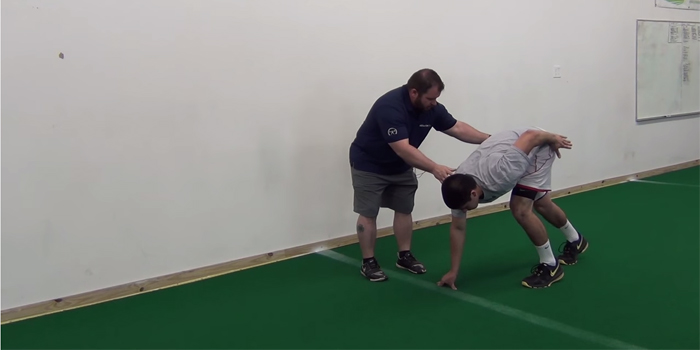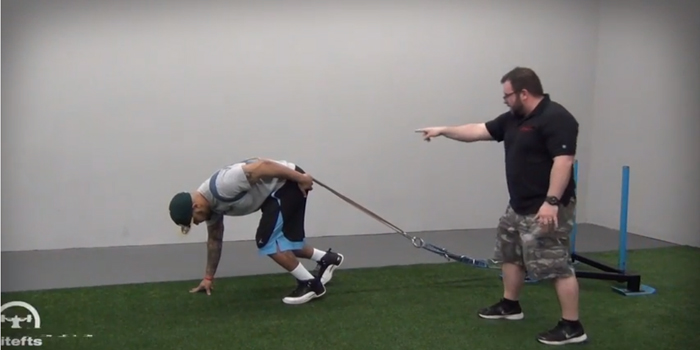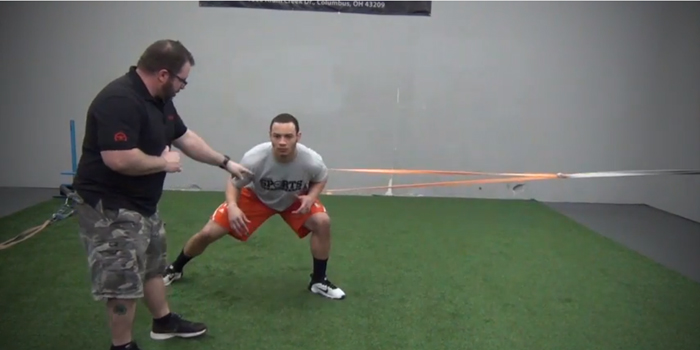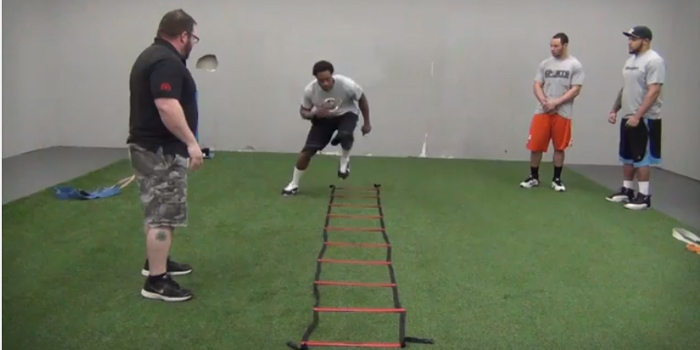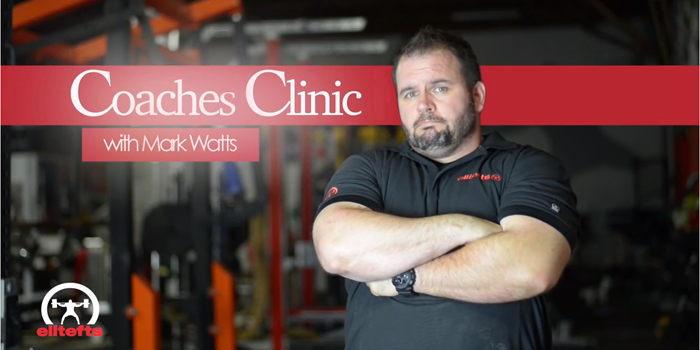
Developing team speed is the holy grail that every coach strives for. Some coaches are in more beneficial situations than others, but we all have to effectively use our time and resources to make the most out of training opportunities.
Adequate speed, agility, and acceleration are all factors that we as coaches don't control. What we can control is often highly variable between athletes. Almost all of my evidence is anecdotal and although I made a ton of mistakes, 1.) I learned from them and 2.) I made the best of the situation I was in.
I explain my learning process in more detail here: 4 Ways I Made my Athletes Slower. Out of all the teams I've trained over 15 years at the college level, here is what I broke it down to:
5 Ways to Improve Team Speed
- Recruit faster players
- Enhance sprint and C.O.D. mechanics through , chunking, repetition, and proper cuing (tactile rather than verbal).
- Increase relative body strength, specifically in the posterior chain.
- Improve body composition
- Improve mobility and postural discrepancies
Basically? Weak, fat, inflexible athletes who run weird; aren't fast.
I wrote in more detail asking How Do You Get Athletes Fast keeping in mind that training speed is much more about Concepts and Context more than the Content of your training plan.
The following drills are very rudimentary, yet some may not be appropriate for beginning athletes. Implementation is contingent on the coach's view of readiness of the athlete. These are not the end all-to-be-all of speed drills. Just the ones I felt improved our team speed when incorporated to our physical preparation plan.
Basic Linear Speed Acceleration Drills in a Team Setting
In this coaching video, Director of Education Mark Watts discusses some basic acceleration drill progressions for a team setting while former elitefts intern Hunter Winans demonstrates.
One of the most difficult tasks for any coach working with non-track athletes is implementing drills that will carry over to enhances performance on the field or court. This video will provide some various starting drills to increase acceleration.
Apologies for Poor Sound Quality
Falling Starts
- Flat Footed
- On Toes
- Knee Hug
- Partner Assisted
- Partner Assisted Knee-Hug (not shown)
- Partner Resisted & Release (not shown)
- Jump Back
Prone Start Series
- 90 Degree Push-Up
- 90 Degree Push-Up with Leg Reset
- 90 Degree Push-Up with Leg Swing
Lateral Starts
- Parallel Stance Review
- Kneeling Start
- SL RDL Start
- Skater Jump Starts
Testing Starts
- Set-Up
- Shin Angles
- Weight Distribution
Testing Athletes
- Measure Stride Length
- Use Video
- Race
Resisted Prowler Sprints
Elitefts™ Director of Education Mark Watts illustrates the set-up and explains the advantages of resisted sled sprints using the prowler. Demonstrating the sprint is Roosevelt Nix who has signed an NFL contract with the Pittsburgh Steelers.
This purpose of the video is not to convince you to incorporate resisted sprinting in your program. The purpose is to provide you with a brief overview of an alternate way to use elitefts™ bands as a more practical harness in a large group setting when using a prowler or sled.
How much weight should I my athletes use?
A general guideline is approximately 10-20% of the athlete's body weight. Generally speaking, the weight used should be heavy enough to elicit a training effect without inhibiting the sprinting mechanics of the athlete.
How far should my athletes be sprinting using resistance?
Again, a general guideline is between a 10 and 20 yard sprint. Longer distances can accumulate fatigue much faster with the additional weight added. In addition the purpose of resistance sprints is to enhance the start of the sprint by adding additional load in a horizontal plane. the longer the athlete sprint in a give distance:
- the posture becomes more upright
- the ground contact time is less with longer strides
- the foot strikes the ground differently (pawing as apposed to pushing)
- different muscle groups are recruiting due to the biomechanical change
An additional technique to incorporate to significantly enhance the training effect of resisted sprinting is contrast training. Simply put, this would require the athlete to perform an non-resisted sprint immediately following the resisted sprint.
Final Thoughts
- Make sure there is enough distance between the athlete and the Prowler® or sled so the front end does not lift up.
- Make sure there is tension on the straps before the athlete starts their sprints
Lateral Start Tutorial
Elitefts™ Director of Education Mark Watts explains 3 commons mistakes when performing lateral starts along with a Change-of-Direction deceleration progression. This video is more appropriate for non-track coaches of beginners in a teams setting.
Lateral starts are an outstanding drill as a pre-cursor to agility drills utilizing power cuts and accompany deceleration drills very well. Sprinting at a 90 degree angle is a skill that can have a direct correlation to increased speed and agility on the field and court. Although this is a hard skill (closed skill), the fundamental movements and biomechanical positions are similar for change of direction on the field or court.
THREE COMMON MISTAKES WITH LATERAL STARTS
Mistake #1: Step with the Front Foot
One common mistake to pushing off the back foot in order to step with the front foot. By stepping with the front foot, the initial movement of the athlete does not significantly move the athletes Center-of-Gravity toward the direction they want to sprint to.
Also, by taking a step with the front foot, the athlete also extends their base and does not allow adequate power production from either foot.
Mistake #2: Pivot before stepping
Another mistake athletes make is to have their first movement turning toward where they are trying to sprint to without taking a step.
When testing, the clock usually starts with the first movement. In athletic competition, it is desirable for the athletes first movement to adequately change the athletes COG toward the target area.
Lastly, pivoting on turf, grass, or the hardwood provides unnecessary friction which can slow the athlete down and place unwanted stress on joints and ligaments.
Mistake #3 Crossover step via Hip Adduction
The crossover step will undoubtedly allow the athlete to cover the most ground with a single step. This changes the the athletes COG and forces the athlete to turn his/her shoulder to perpendicular to where they are sprinting to.
The issue with the crossover step is this action can take much longer to execute. One reason being the athlete cannot generate as much power from the front leg when they are "pulling" via adducation with the front leg. In this case, shifting the COG towards the target before executing a crossover step is ideal.
LATERAL SPEED & COG PROGRESSION
- Lean & Crossover
- Reposition Step with Pause
- Reposition Step and Sprint
- Shuffle to Start
- Shuffle back to start with pause
- Shuffle back to start & sprint
- Sprint back to start with pause
- Sprint back to start with sprint
Lateral Speed Drills with Bands
Lateral speed is imperative for all field and court sports. The ability to explosively brake and produce force in the opposite direction is what separates good players from average and what keeps athletes out of the training room.
There are two aspects of coaching agility that can improve the the comprehension and execution of better mechanics and more force production. Incorporating pauses where the athletes "sticks" the landing, and providing a tactile cue such as a resistance band, can help athletes improve lateral speed.
Stick the Landing
As many coaches have presented on this topic, almost all of them start their progression where the athletes pause at the landing. This allows for the athlete that is often dependent on the stretch-reflex to develop a better awareness of positioning at the amortization phase.
Bands for COD
Adding bands can assist the athletes in becoming cognizant of proper weight distribution and stabilization techniques otherwise missed without them. Bands can also give the athlete a tactile cue to help with proper sequencing when producing force in the concentric phase.
Lateral Speed Mechanics with Bands
In this video Ryland Ward (BGSU alumn), demonstrates several change-of-direction deceleration drills and progresses into some resistance agility exercises using bands. The bands should only be implemented once the athlete first demonstrates proper landing mechanics without external resistance. For intermediate athletes, the bands can provide an additional tactile cue to reinforce and master specific positions.
Progression
- Shuffle away from band tension to pause.
- Shuffle toward band tension and pause.
- Shuffle toward band tension, pause, and sprint.
- Shuffle toward band tension and sprint.
Lateral Bounds with Bands
In this video, Verlon Reed (Detroit Lions) demonstrates a skater jump progression to reinforce landing mechanics and body positioning for change-of-direction mechanics. The bands should only be implemented once the athlete first demonstrates proper landing mechanics without external resistance. For intermediate athletes, the bands can provide an additional tactile cue to reinforce and master specific positions.
Progression
- Skater jump and stick the landing.
- Reactive skater jumps away from resistance.
- Reactive skater jumps toward resistance.
Agility Ladder Drills Can Actually Work
One thing is a certainty when speaking about internet behavior. That is, people will get butt-hurt about how other individuals train. Some arguments get the internet warriors more emotional than others. Talking about Raw vs Gear, Carbs, CrossFit, and recently... Agility ladders. People insist on taking a side on these issues and the use of agility ladders are no different. Like any topic of debate, it usually comes down to context.
This video has been floating around Social Media and basically replicates what "Agility Ladder Footwork" would look like on the field.
How football would look if "agility" ladder drills actually applied to a game situation. pic.twitter.com/c78ooBnmQE
— Joseph Potts (@TopSpeedLLC) May 13, 2015
My Take
To be honest, I am not a huge fan of the implement, but I have used them as a coach. I can see why other coaches use them and conversely, why some coaches avoid them like the plague. Here's some quick True-False statements on what I believe. For the sake of this article, lets use the title agility-ladder and speed-ladder interchangeably.
Agility Ladders are an adequate warm-up variation. TRUE
Athletes can become very complacent and variety is your friend as a coach. Incorporating agility ladder drills can prepare
Parents love Agility Ladders. TRUE
Parents love seeing their 8-10 year-olds do rehearsed patterns through these ladders. Again, for the younger athlete, providing them with drills where they can reinforce body-awareness and require them to move their feet fast is not going to hinder their physical development. There are developmental windows that would make programming these types of drills beneficial.
Using Agility Ladders will improve my foot-speed on the field or court. FALSE
Whatever pattern you have had your athletes memorize and perform, please note that these are specific to the learned and rehearsed movement. The skill acquisition is specific to that pattern. To say there is carryover to having "quick feet" on the field or court is naive.
Athletes running through every pattern imaginable thorough the ladders are moving their feet as fast as they can without covering any ground. Working on how fast they can put one foot down next to the other and not understanding why this isn't equating to an explosive "first step". We see people every day that take a lot of small steps and give the impression they are athletically gifted. The problem is how much ground is covered on each step is minimal
Agility Ladders will improve my ability to change directions: FALSE
Well, not entirely false. But, it is impossible to replicate the ground forces and joint angles that an athlete would need to endure playing at full speed with a ladder drill. The biomechanical positioning and force require to reduce the amortization phase does not equate when performing drills in a ladder.
With that being said, there are a few drills that can help athletes with some mental and physical cues to achieve similar positions. These may be excellent drills to incorporate into the warm-up while still predisposing athletes to the basic mechanics of each particular cut.
Two Lateral Speed Drills
Here are two drills that can actually benefit athletes in simulating basic change of direction body positions.
In this video, Verlon Reed (Detroit Lions), Ryland Ward, (BGSU Alumn), and Roosevelt Nix (Pittsburgh Steelers) go through two drills on the ladder. Notice that with 3 different athletes playing 3 different positions, these reps will all vary in execution.
1. Icky Shuffle - Power Cuts
The Key is to emphasize pushing off the outside foot and keep the COG over the inside foot
2. Cross Overs -Speed Cuts or Lateral Starts
This will reinforce driving the opposite knee while keeping weight on the outside foot to change directions.
The key with both drills is body positioning, a low center-of-gravity, and executing the proper footwork.
Linear Speed
One drill that can be successful in the development of linear speed are single leg sprints or bounds. These drills can be done without a ladder, but the ladder provides a built-in sequenced progression.
This is not for beginners or to be implemented early in the training cycle as there is a bit of a learning curve for any non-track athlete. This drill can have a significant carry-over in sprint speed due to the accentuated ground contact force and the biomotor similarities in the drills at certain stride lengths for the single leg drills. Here is the progression. Note: Not all athletes will progress to the fourth progression. The third progression may serve as single-leg bounds depending on the training age and athletic ability.
- Single Leg Hops - Every hole (not shown)
- Single Leg Runs - Skip One Hold
- Single Leg Sprints - Skip Two holes
- Single Leg "Bounds" - Skip Three Holes (not shown)
A few tips on improving technique with this drill would be to ensure proficiency in some prerequisite drills including:
- Single leg broad jumps
- Single leg box jumps
- Alternating leg bounds
Coaching tips
- Have the athlete job up to the start of the ladder or line to gain forward momentum to execute the movement
- Ensure the athlete sprints after completing the ladder
This is not to say these drills, if incorporated into your training program will significantly enhance speed and agility. This is just to say that agility ladders can have some merit in any training program.
Articles by Mark Watts
Olympic Lifting for Athletes: Using Static Holds to Improve Technique
Head Games: Training the Neck to Reduce Concussions
The Fastest Sport on Ice: Things You Don't Know About Bobsled
Tips to Crush the Combine Tests
An In-Season Training Guide for Baseball Pitchers
Individual Training in a Team Setting
Off-Season Training for Football (with 8-Week Program)
What is Really Wrong with Strength and Conditioning
The Last Sports Performance Podcast
Olympic Lifting for Athletic Performance
Sports Performance Coach Education Series
WATCH: How to Find a Strength and Conditioning Job
WATCH: Becoming a Mentor to Young Coaches
WATCH: The Four-Step Coaching Process
WATCH: 5 Strategies to Perform More Work in Less Time
WATCH: Why Communication is Key to a Better Coaching Career
WATCH: A Better Way to Train High School Athletes
WATCH: How to Implement Auto-Regulatory Training in a Team Setting
WATCH: Pre-Workout Circuits to Optimize Training Time and Maximize Performance
WATCH: Hypertrophy Circuits for Athletes in a Team Setting
Coaches Clinics
WATCH: Two Bench Press Mechanical Drop-Sets for Hypertrophy
WATCH: Two Lateral Speed Drills with Bands to Improve Change of Direction
WATCH: Adjusting the Glute-Ham Raise to Optimize Your Training
WATCH: Basic Linear Speed Acceleration Drills in a Team Setting
WATCH: Kettlebell Training for Team Sports









